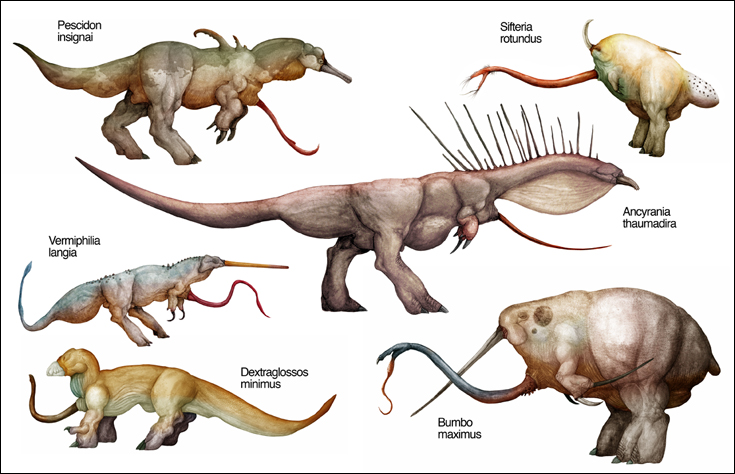Pescidonts
Pescidonts are near-cousins of the fabled Kahydroniformes. The primary difference between these two clades is not, as one might think, the bipedal gaits of the Pescidonts. In fact, some Pescidonts do have quadrupedal gaits, and bipedal true Kahydrons are known from fossil remains. The main difference between Kahydroniformes and the Pescidonts is actually the presence of a well-developed hydraulic bite on the Kahydrons’ first-head jaws. Pescidonts, on the other hand, have conventional muscles in this region and their hydraulics do not extend beyond their necks.
The lack of this adaptation seems to have excluded the Pescidonts from large-predator niches. Instead, these creatures prosper in a dazzling variety as small hunters, “snake eaters,” scavengers and even herbivores.
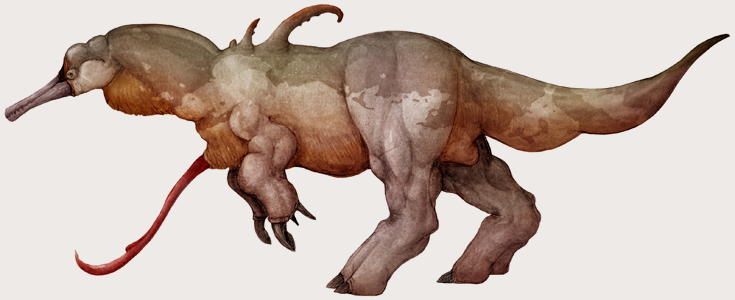
Species: Pescidon insignai
Common Names: Pescidon (This is the only Pescidont that is generally known as such.)
Size: 3 meters, but usually less.
Habitat: All of Vesterna north of the Divider Alps, also abundant in North-Western parts of Isterna.
This is a typical Pescidont, if anything can be considered “typical” in this diverse and hugely varied family. It runs on two extended hind legs, its front legs have spade-like claws used for digging and grasping, and its jaws are thin and elongated, able to snap up suddenly on fast-moving small prey. Its second head is extensible and quite long for a creature this size, yet still small compared to those of some other Pescidont groups. With these adaptations, it hunts for creatures as small as Trikes and as large as Chopsticks. (Lygodectes sp.) Very rarely, vicious “berserker” individuals have been observed trying to attack larger herbivores such as Pneumagazelles and Rollpigs (Xenosus sp.) Like many other Pescidonts, they also take fruits and plants as a dietary supplement.
These creatures are among the most social large animals on Snaiad, usually living in clearly defined family groups or “tribes.” Individuals often stroke and groom each other with their elongated second heads. This action seems to give them pleasure and strengthen social bonds. They are curious and investigative by nature and this extends well into their relations with human beings, whom they are not afraid of. They never attack people unless provoked, and settlers usually offer them food and water around their homes. In return, the Pescidons alert the human residents of potential danger and even fight against intruding large predators. This mutualistic cooperation saved a lot of lives during the infamous “Arbophobe Wars,” making the Pescidons the favorite indigenous pets of the Snaiadi people.
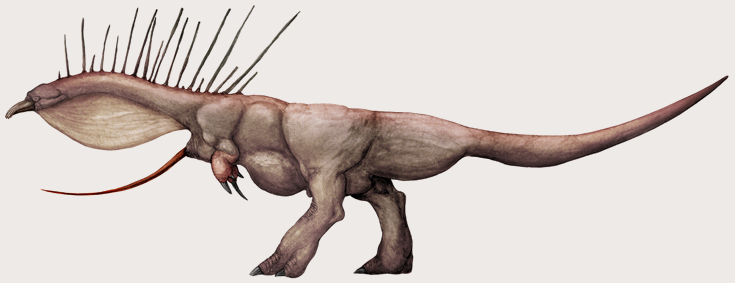
Species: Ancyrania thaumadira
Common Names: Spearneck, Desert Loper.
Size: More than 5 meters long.
Habitat: The Great Ankyranian Desert.
Like a surreal mirage walking across the sand dunes, this close relative of the common Pescidon is one of the largest animals that can tolerate the extreme conditions found in the Great Ankyranian Desert. It has numerous special adaptations to live there, such as a fat storing tail, long, heat-regulating flaps on its neck and back and sand-proofing flaps in its eyes and two heads. The purpose of the long, rattling spikes on its neck remains a mystery; they could work somehow to condense water from the morning dew, serve as protection against predators such as Dune Fututors (Ammofututor harkoneeana,) or work as inter-sexual display devices.
Unlike many of its Pescidont cousins, this animal is more of an herbivore, subsisting mainly on the thorny desert shrubs or the root-like growths it digs from under the sand.
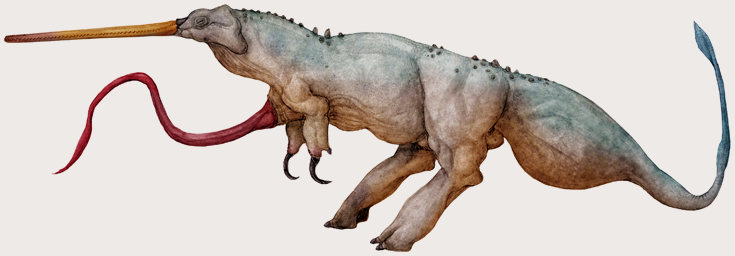
Species: Vermiphilia langia
Common Name: Sprog-Prober.
Size: 1.5 meters long.
Habitat: Sprogland across Vesterna.
The hole-riddled, mat-like layers of sprog are a form of vegetation unique to Snaiad. A staggering variety of small-to-medium sized, usually serpentine creatures dwell among the spongy interior of these abundant growths, forming a potentially rich food source for any creature that can catch them. On the mainland continents of Snaiad, small Vermidont Pescidonts such as Vermiphilia have tapped into this resource by evolving long first-head beaks, with which they “probe” the sprog for the animals inside. Their second heads are also extremely elongated and snake-like, able to dive into sprog for further pursuit of their serpentine prey. If all measures fail, these Vermidonts can also use their hook-like claws to rip apart the obscuring layers of sprog. Their hips have specialized joints and their bodies and tails form a distinct, seesaw-like balance that makes “dipping” easier and more energy-efficient.
There are more than a hundred species of these interesting creatures on Snaiad, each usually confined to a very specific region. On the isolated island of Thalassia, the Monoanticheran Snake-Eaters have also evolved to look and act like Sprog-Probers, although they hail from a completely unrelated lineage.
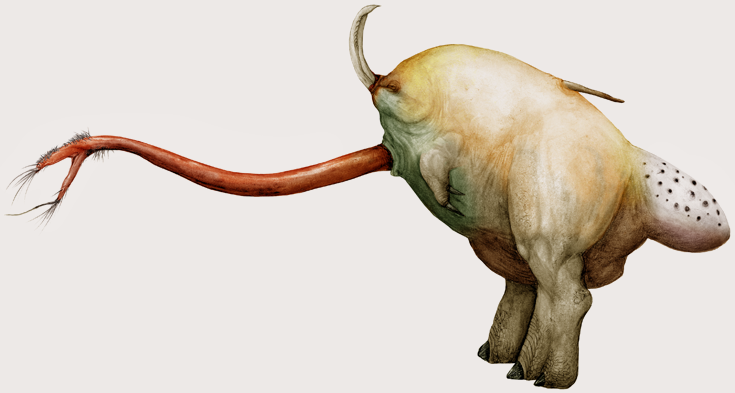
Species: Sifteria rotundus
Common Names: Spotted Topaki, Golden Ball, Triggerback.
Size: 60-70 centimeters tall.
Habitat: Western Neomediterranean shores, extending into the Great Western Pinnacle Range.
These spherical creatures have been classified in their own group for a long time, but they are actually Pescidonts, albeit highly derived ones. With first-head faces mashed directly into their bodies, they exhibit Primary Acephaly; a common condition on Snaiad where large land animals have two heads but no brains or vital organs in either of them. Primary Acephaly usually affects “freak” individuals only, but for some reason it has taken root in the Bumboiforme Pescidonts.
These animals feed on anything they can find, including smaller animals, trikes, plants and even bits of carrion. Their second heads are hugely extended, with jaw-like flaps and sensitive whiskers on their ends. They sometimes venture into water to escape predators, and this is how Snaiadi zoologists think their amusing descendants, the marine Blumbomeniformes, initially evolved.
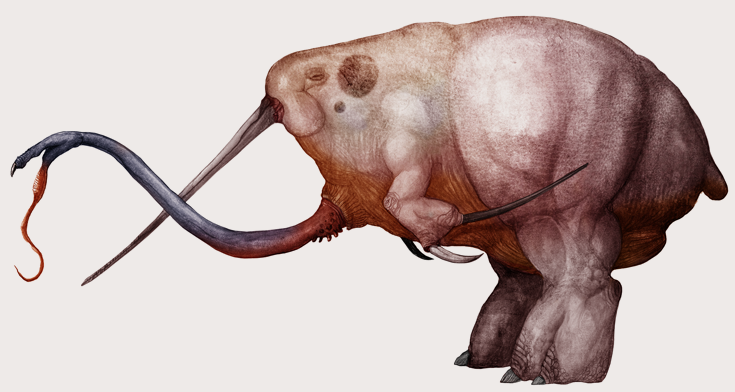
Species: Bumbo maximus
Common Name: Tank Topaki.
Size: 2-3 meters long.
Habitat: South-Eastern Istenra except the Ankyranian Desert, also present in Oroland.
A giant among the Bumboiforme Pescidonts, this hulking, heavy beast is essentially a scaled-up version of its smaller cousins. It browses in the plains, scrublands, pinnacle-range galleries and sprog-plains, looking for anything it can eat. It has a long, spear-like beak emerging from what is left of its first head, used not only for self-defense but also as a “sprog prober” like the beaks of its Vermidont cousins. The males regularly grow and shed antler-like hand-claws that are almost as long as their beaks.
Out of the numerous Bumboiforme species, B. maximus is the first discovered and only domesticated one. Snaiadi settlers used them as draught animals in the initial years of colonization, but with the widespread availability of cars and nanorail, only hobbyists and zoos breed them these days. Human-derived breeds include the famous Smyrniote Giant Pumpkin, as well as the dwarf Tomato Jousters.

Species: Dextraglossos minimus
Common Name: Golden Kahydron, Aarite Kahydron.
Size: 75- 90 centimeters.
Habitat: The island of Aar.
These animals’ common name as “Kahydrons” reveals their mistaken origins at their initial discovery. Honestly, it is difficult to blame the early explorers since with their tiny hoof-and-claw forefeet and quadrupedal gaits, Dextraglossos’ perfectly resemble Kahydroniformes, albeit very small ones. Only later, when dead specimens were dissected did their true origins as derived Pescidonts emerge. These creatures, although superficially Kahydron-like, lack the signature hydraulic jaws of the Kahydroniformes. Their origins on the isolated island of Aar are also a mystery, debate rages on about whether, they were already present on Aar when it broke apart from Isterna, or whether they rafted over from the mainland later.
Oblivious to the mysteries surrounding them, these dwarfed creatures live as generalist predators on Aar. One remarkable characteristic they have is their amazingly dexterous second heads, with which they can grasp and carry objects, groom and tickle each other and even make primitive tools. Individuals have been observed using sticks to probe burrows and sprog and using stones to break open land clams.
Copyright laws protect all intellectual property associated with Snaiad.
All artwork, concepts and names associated with this project belong to C. M. Kosemen, unless otherwise stated.
